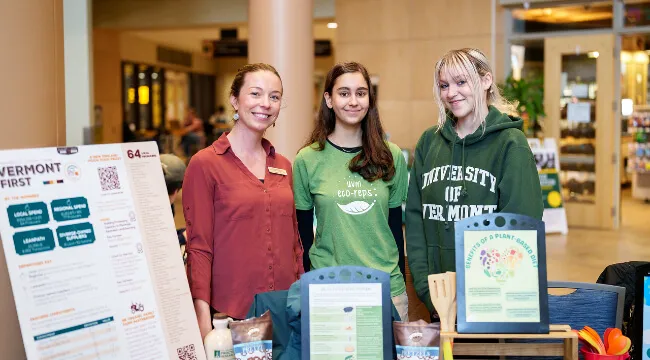What we eat and where our food comes from are important to University of Vermont community members. When a 2022 survey asked students, faculty and staff to rank what areas of campus sustainability should be addressed first, food came in third, just behind energy and buildings.
This feedback informed the university’s Comprehensive Sustainability Plan, which commits UVM to increase spending on Vermont-grown food to 25% by 2030.
Behind the scenes, Nicole Reilly, UVM Dining’s Sustainability and Campus Partnership Manager, has been working on this goal. Part of her role is connecting with businesses throughout the state to source more local and organic food for the campus community.
First, tell us a little more about why working with local producers is a more sustainable approach.
Nicole Reilly: Making connections with and supporting local farmers and producers is one of the favorite parts of my job. Since its inception in 2014, the Vermont First program has been committed to supporting the local economy and community. We work closely with our distributors to identify local and seasonal foods, and implement a tiered purchasing strategy, prioritizing local first, then regional, then beyond. Not only does buying local food circulate more money in the local economy, but you also learn more about where your food comes from.
Throughout the years, our team has met the farmers that grow our food, have toured their fields and facilities, and better understand their growing practices. These organic and regenerative growing practices help support soil health and carbon sequestration and help reduce environmental impacts of farming. Buying local food also reduces the miles that food travels to get to campus. Our commitment to prioritizing local food and encouraging a more plant-forward lifestyle feeds into the university’s Planetary Health goals—building a resilient regional food system means healthier diets and a stronger local economy for all.
It looks like you are up to 91 local producers supplying food to campus. Is that number on the rise?
Nicole Reilly: Yes, that’s up from 76 local producers the previous year. We serve an average of 80,000 meals each week, so our food purchasing has a profound impact on the local food system. From July 2023-June 2024, over 1.7 million dollars, or 15.5% of the total food purchased on campus, was local (defined as grown/manufactured in Vermont). Our Vermont First Team and eExecutive cChefs identified several key strategies to implement last year, including moving to 100% local coffee, using local cheddar on our delis, opening the UVM Burger Co. which features local burgers and hand-cut fries, and introducing new local snacks and beverages to our retail locations. These changes resulted in an increase of 4.1%, well above our target growth that year. This work continued to accelerate through the fall 2024 semester, as our team focused on adding specials in retail locations featuring our Harvest of the Month, and expanding our partnership with Stewarts Bakery and Miller Milk into most dining locations. We proudly expanded our local food percentage to 20.9%.
How does local food sourcing work in practice? Do vendors come to you, or do you reach out to them?
Nicole Reilly: It’s a mixed approach. Sometimes food businesses reach out to us directly to sell their product. If the product is a good fit, then we connect them with a distributor who will carry their products. As part of this process, we commit to purchasing a certain quantity of products to ensure viability. A recent example would be onboarding Vermont Nut Free Chocolates. Black River Produce began carrying their line, and now it is available not only at UVM, but also in five other states. At other times, we reach out to producers to develop products specifically for UVM, to close the gap on products or categories of food that are not currently in the local food supply chain. A great example of this is our partnership with Miller Milk. Two years ago, we started selling their delicious maple and chocolate milk, then we began exclusively using their milk in catering. We wanted to continue to support their business in larger ways and identified an opportunity if they were able to make bags of their half and half for the creamer machines on campus. We worked with them over the summer to put this into motion and starting this fall, are now using their product almost exclusively on campus. This change helps us meet our commitment to increasing our purchasing of local and organic dairy through the Northeast Organic Family Farm Partnership and will more than double our purchasing of the Miller Milk products, a huge win for this small producer.
Where we source our food is a reflection of UVM’s values, and a key component of UVM’s Comprehensive Sustainability Plan. The CSP has also set ambitious goals in the sectors of transportation, decarbonization and waste management to achieve the goal of carbon neutrality by 2030.
